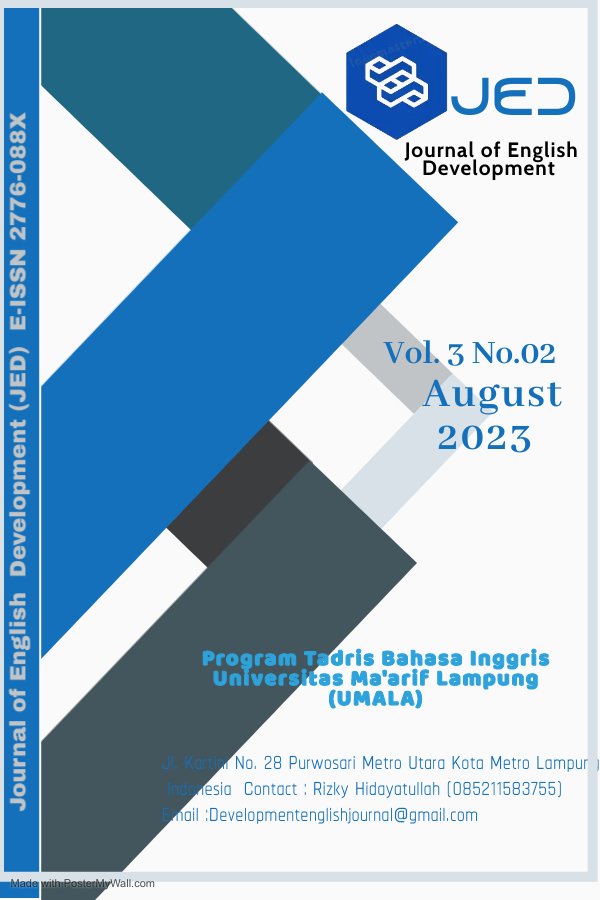The Correlation between Learner Autonomy and English Competence of 8th Graders at a State Junior High School in Surabaya
English
DOI:
https://doi.org/10.25217/jed.v3i02.3709Keywords:
English Competence, Language Learning, Learner AutonomyAbstract
This research aimed to investigate the connection between learner autonomy and English competence among 8th-grade students. A correlational design was employed using questionnaire surveys and students' scores in midterm and final examination. The study involved 75 students from a state junior high school in Surabaya. The questionnaire assessed learners' autonomy behaviors, goal-setting skills, and willingness to take responsibility for their language learning, while English competence was measured using students' report scores book. The findings indicated that the 8th graders exhibited a high level of learner autonomy, showing self-directed learning behaviors and taking individual responsibility for their language learning. Furthermore, there was a significant positive correlation between learner autonomy and English competence suggesting that students with greater autonomy tended to demonstrate higher English competence. These results highlight the importance of nurturing learner autonomy to improve English competence. Educators and policymakers can use these findings to develop strategies and interventions that promote learner autonomy and enhance English language learning outcomes. Further research is recommended to explore other factors influencing learner autonomy and its relationship with English competence. Qualitative studies could provide deeper insights into students' perceptions and experiences regarding learner autonomy and its impact on their language-learning journey.
References
Aneski, F. M. (2022). The The mplementation of English Speaking Activities on Students At Modern Al-Furqon Islamic Boarding School, Panaragan Jaya, Tulang Bawang Barat: Speaking activities. Journal of English Development, 2(02), 109–116.
Muchsonny, M., Rahman, F., & Hidayatullah, R. (2021). The Study Of Bilingual Milieu Toward The Student’s Speaking Performance At Modern Boarding School: English. Journal of English Development, 1(01), 45–52.
Reeve, J. (2006). What Teachers Say and Do to Support Students ’ Autonomy During a Learning Activity. Journal of Educational Psychology, 98(1), 209–218. https://doi.org/10.1037/0022-0663.98.1.209
Benson, P. (2001). Teaching and Researching Autonomy in Language Learning. London: Longman pdf.
Çeliköz, Nadir & Sarı, İrfan. (2017). EFL Proficiency in Language Learning and Learner Autonomy Perceptions of Turkish Learners. Journal of Education and Practice. 8.
Dafei, D. (2007). An Exploration of the Relationship between Learner Autonomy and English Competence. Asian EFL Journal: Teaching Articles, 1-23. Busan: Asian EFL Journal Press. Retrieved from http://www.asian-efl-journal.com.
Dam, L (2009). The use of logbooks–a tool for developing learner autonomy. Maintaining control: Autonomy and language learning.
Dickinson, L. & Wenden, A. (Eds.). (1995). Autonomy, self-direction and self-access in language teaching and learning. Special issue of System, Volume 23, Number 2.
Gahremani, K & Zarei, A. A. (2010). On the Relationship between Learner Autonomy and Reading Comprehension. TELL, Volume 3, Number 10, 81-99.
Hadley A, O. (1993). Teaching Language and Context. Boston: Heinle & Heinle.
Holec, H. (1981). Autonomy and foreign language learning. Oxford: Pergamon Press. (First published in 1979, Strasbourg: Council of Europe).
Kementrian Pendidikan dan Kebudayaan. (2012). Kurikulum 2013. Jakarta: Kemendikbud.
Khasinah, Siti. (2014). Factors Influencing Second Language Acquisition. Englisia Journal. 1. 10.22373/ej.v1i2.187
Little, D. (2007). Language learner autonomy: Some fundamental considerations revisited. Innovation in Language Learning and Teaching, 1(1), 14–29. https://doi.org/10.2167/illt040.0.
Maud, Ciekanski. (2007). Fostering Learner Autonomy: Power And Reciprocity In The Relationship Between Language Learner And Language Learning Adviser. Cambridge Journal of Education. 37:1. 111-127. https://doi.org/10.1080/03057640601179442.
Myartawan, I Putu N. W., Mohammad A. L., & Suharmanto. (2013). The Correlation Between Learner Autonomy and English Competence of Indonesian EFL Collage Learners. TEFLIN Journal, Volume 24, Number 1, 63-76.
Oxford, R., L. (1990). Language Leaning Strategies. Boston: Heinle & Heinle Publisher.
Oxford, R. L., & Burry-Stock, J. A. (1995). Assessing the use of language learning strategies worldwide with the ESL/EFL version of the Strategy Inventory for Language Learning (SILL). System, 23(1), 1–23.
Perinetti, G. (2019). StaTips Part VI: Bivariate correlation. South European Journal of Orthodontics and Dentofacial Research. (2019), 6(1).
Reeve, J., & Jang, H. (2006). What teachers say and do to support students' autonomy during a learning activity. Journal of Educational Psychology, 98(1), 209–218. https://doi.org/10.1037/0022-0663.98.1.209
Vetter, Thomas R. MD, MPH. Descriptive Statistics: Reporting the Answers to the 5 Basic Questions of Who, What, Why, When, Where, and a Sixth, So What?. Anesthesia & Analgesia 125(5):p 1797-1802, November 2017. https://doi.org/10.1213/ANE.0000000000002471.
Zhang, L., & Li, X. (2004). A Comparative Study on Learner Autonomy between Chinese Students and West European students. Foreign Language World, Volume 24, Number 4, 15-23.

Downloads
Published
How to Cite
Issue
Section
License
Copyright (c) 2023 Violla Eka Fernanda, Ahmad Munir

This work is licensed under a Creative Commons Attribution-ShareAlike 4.0 International License.





